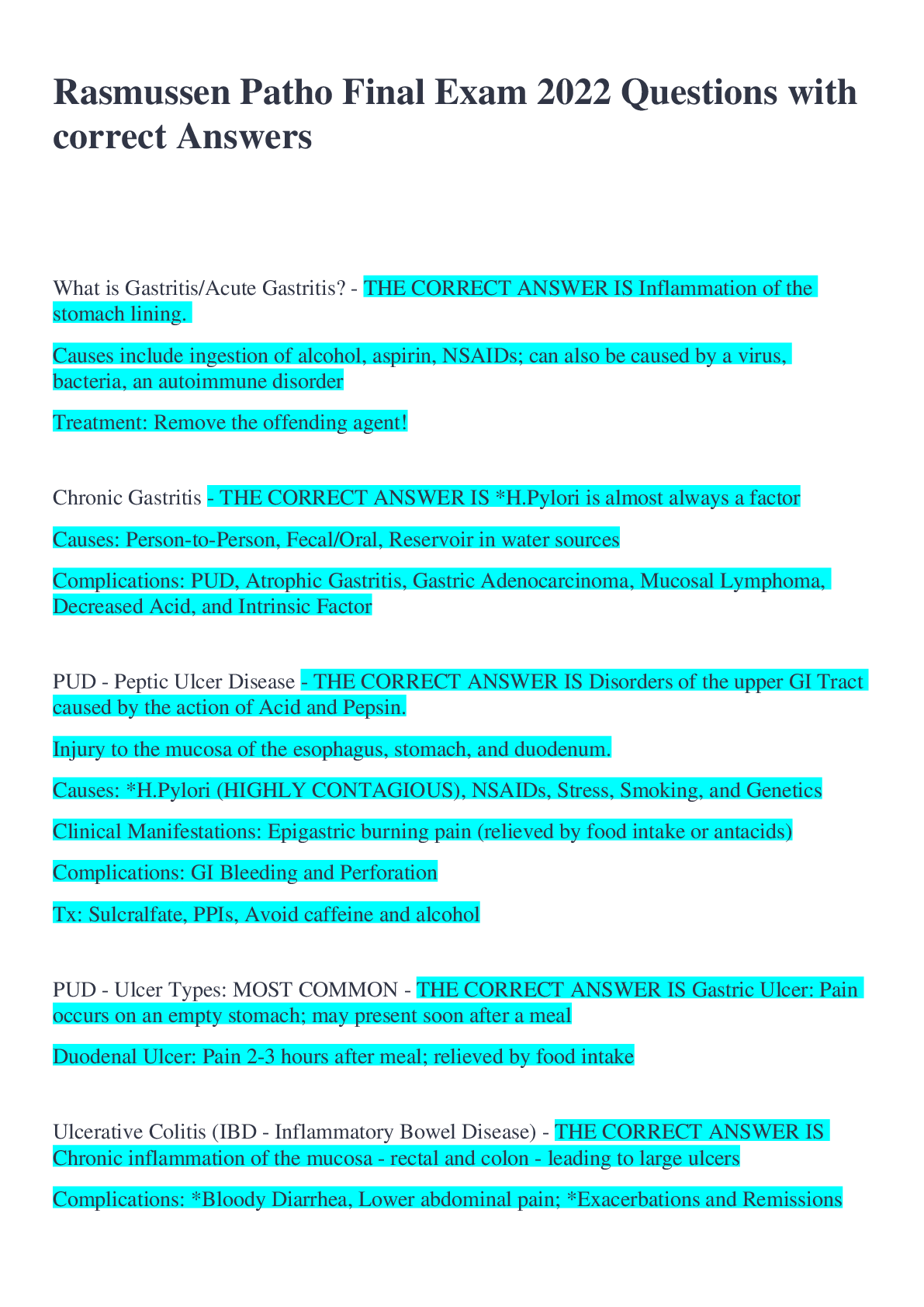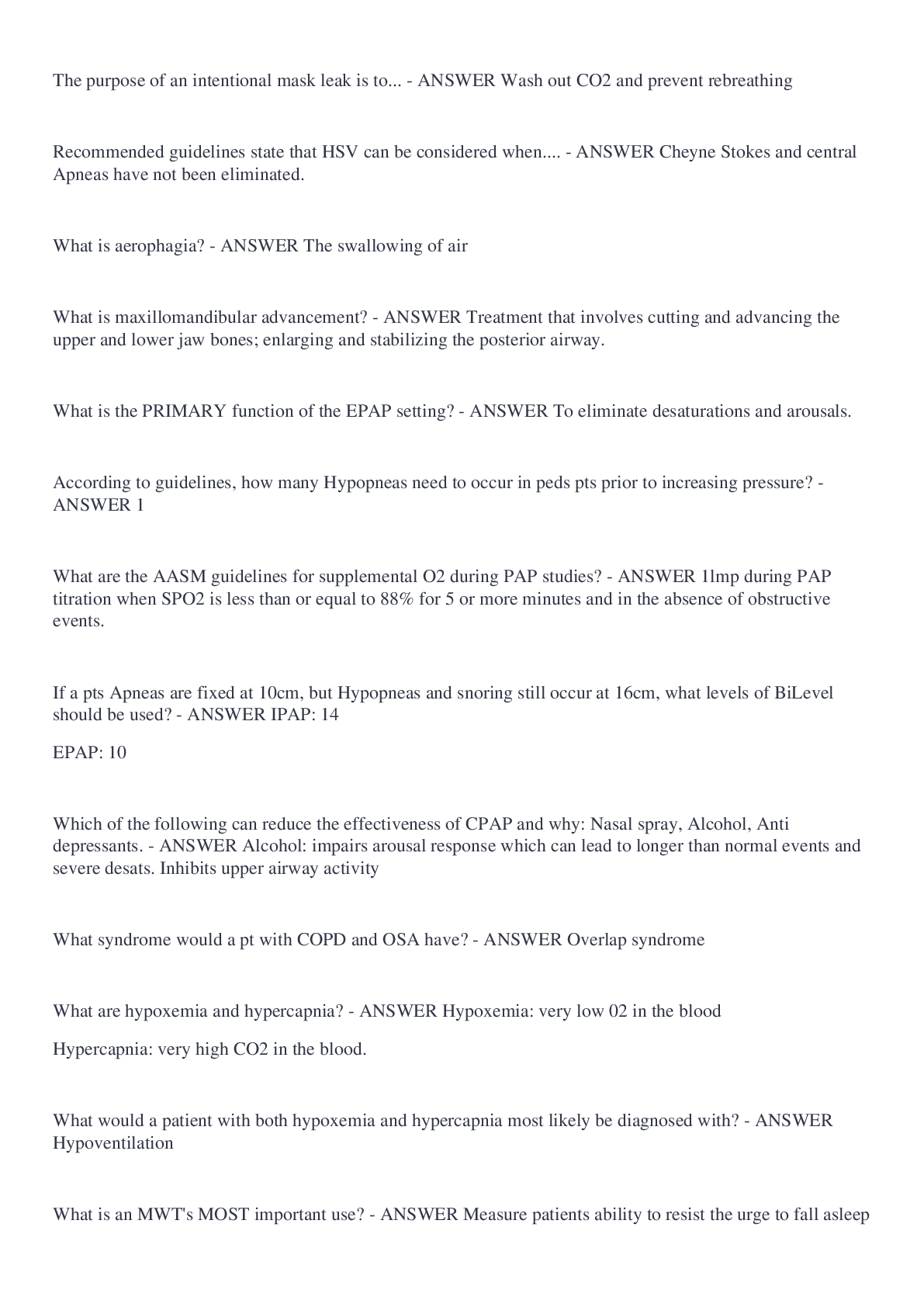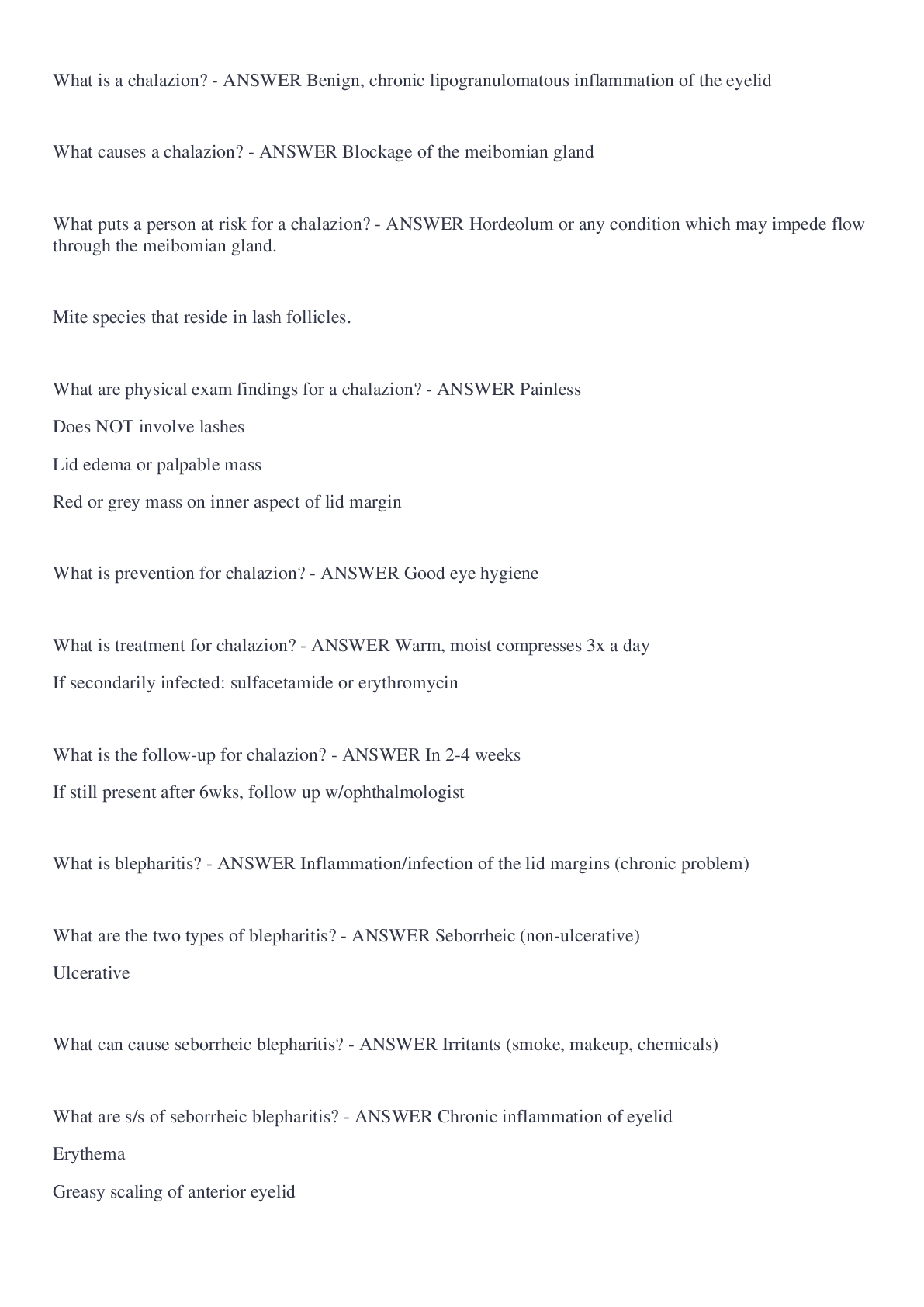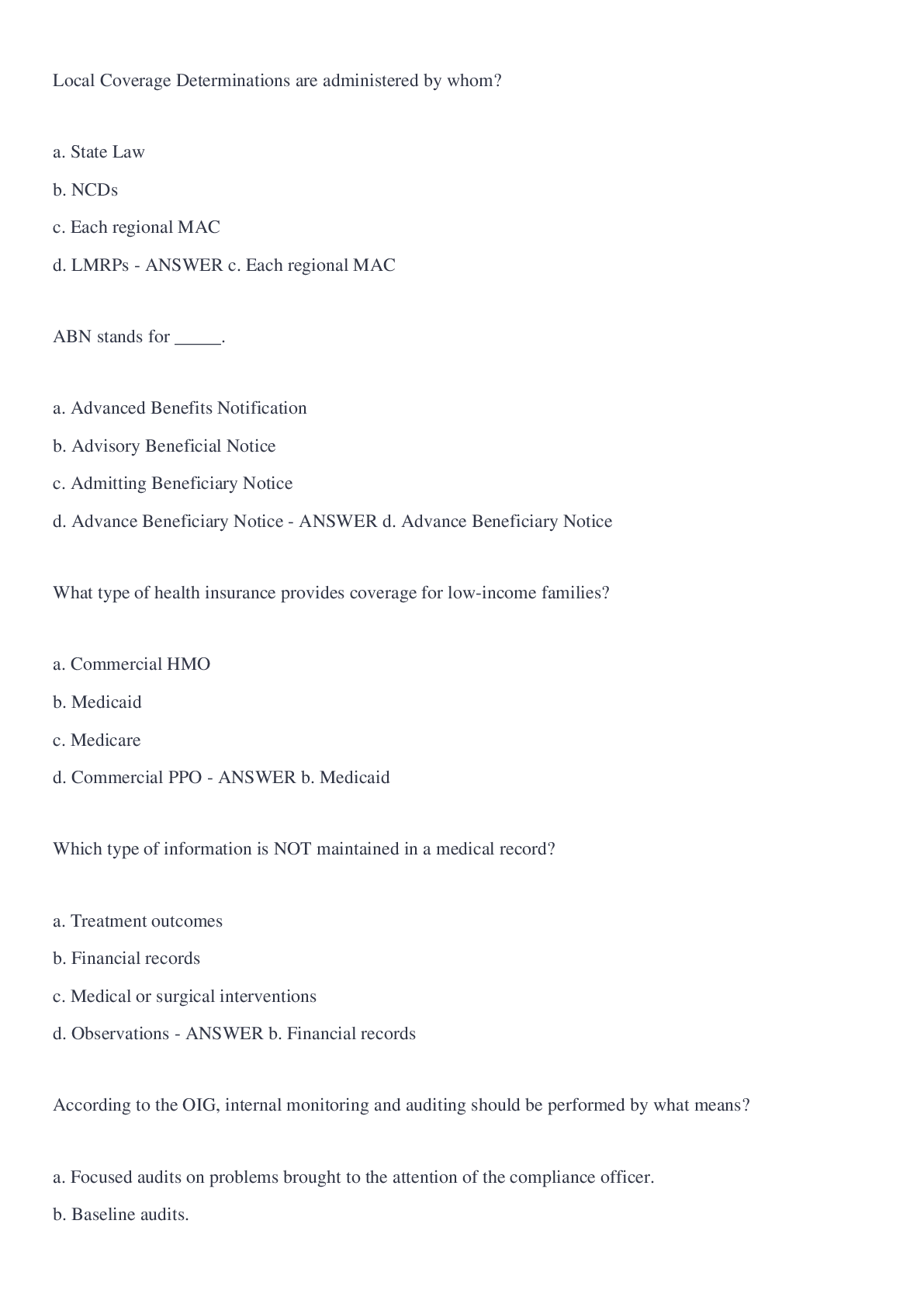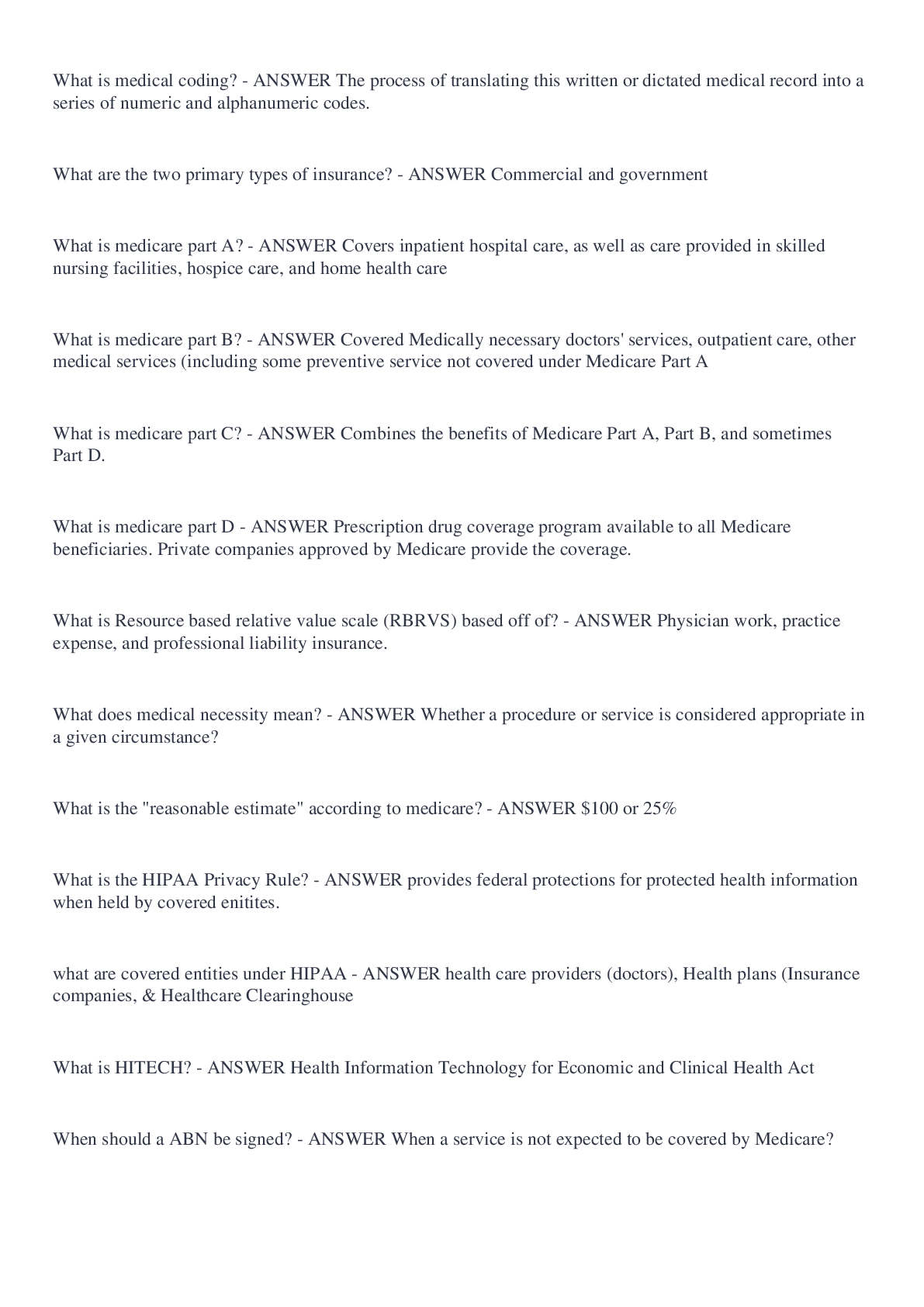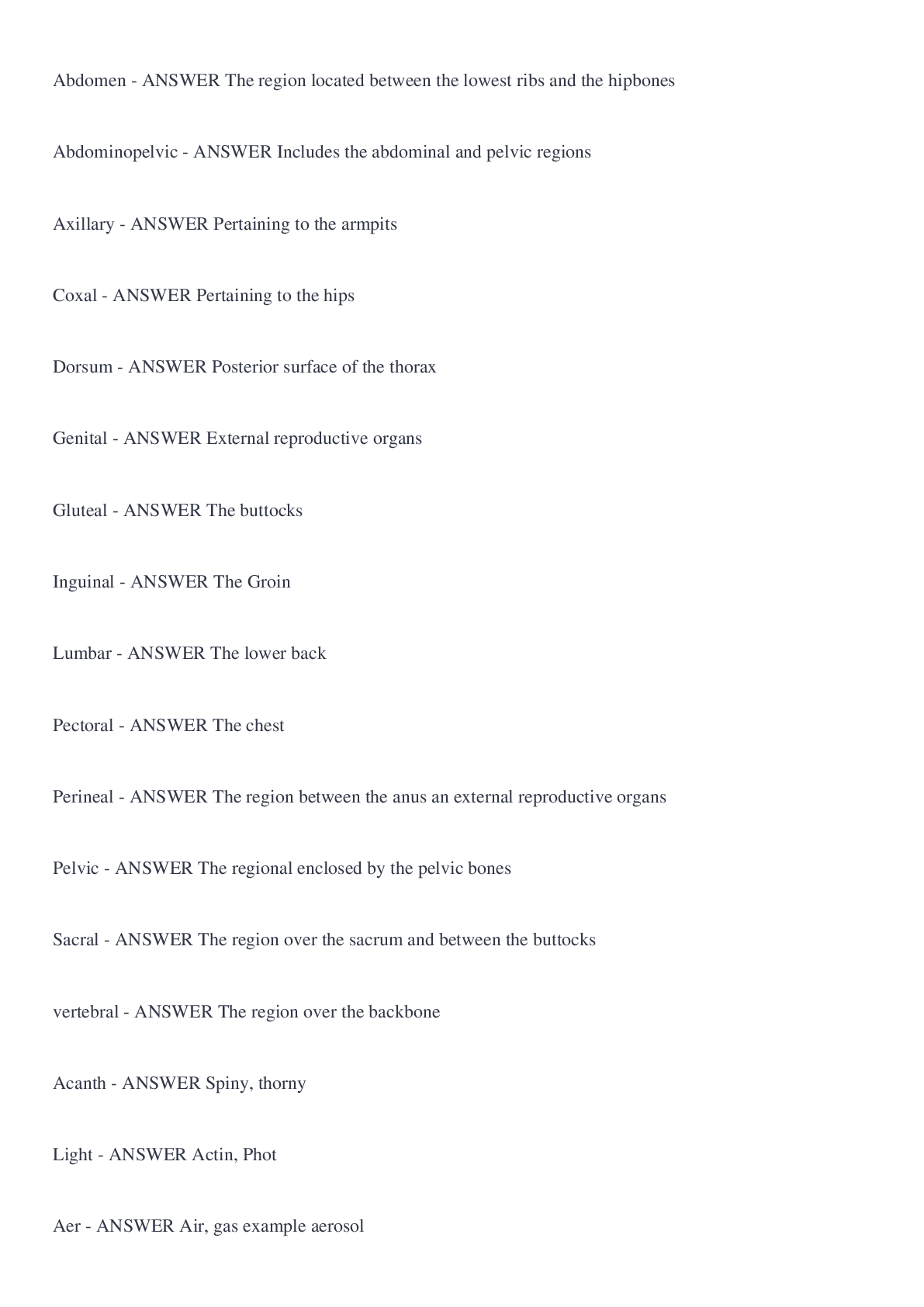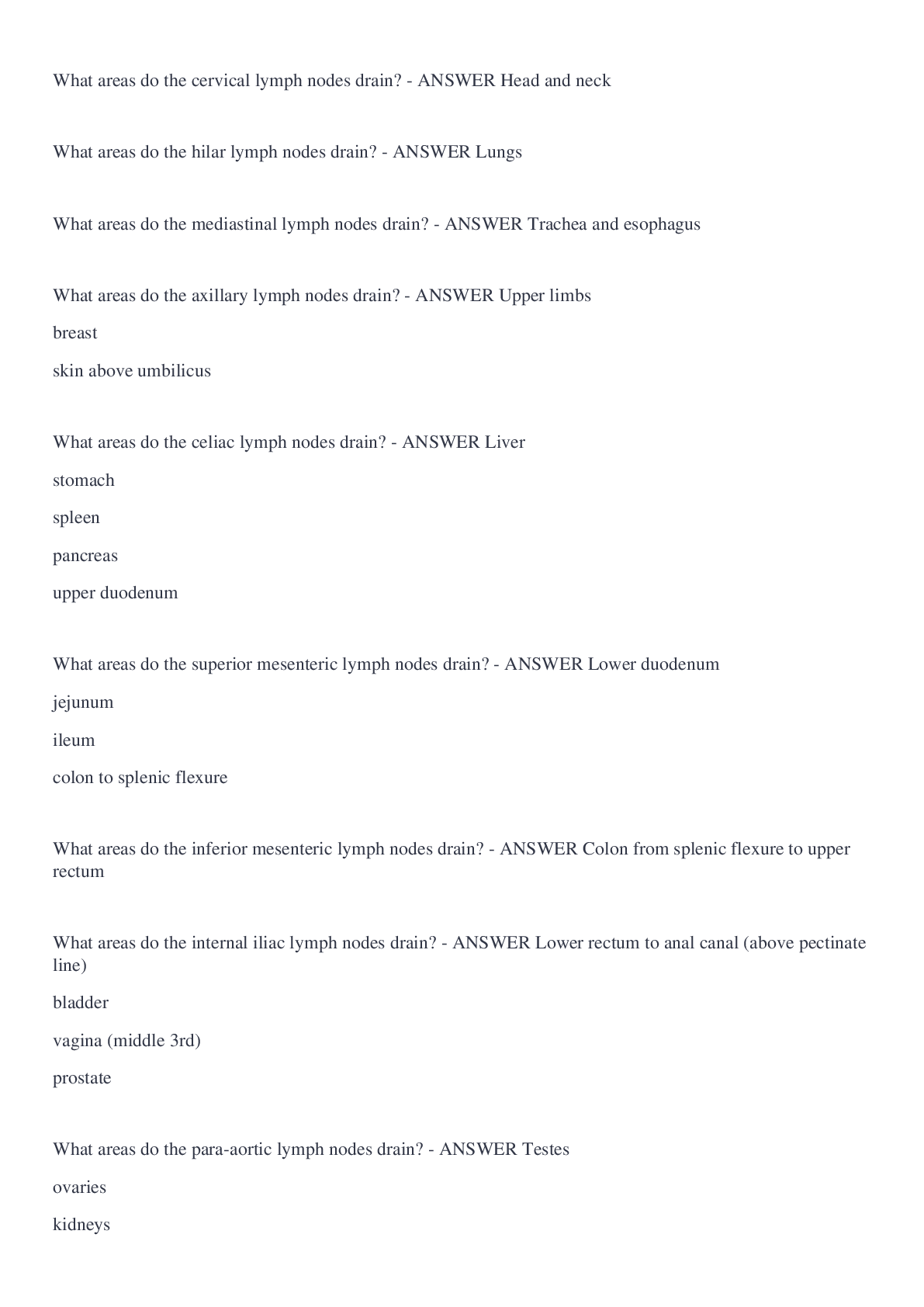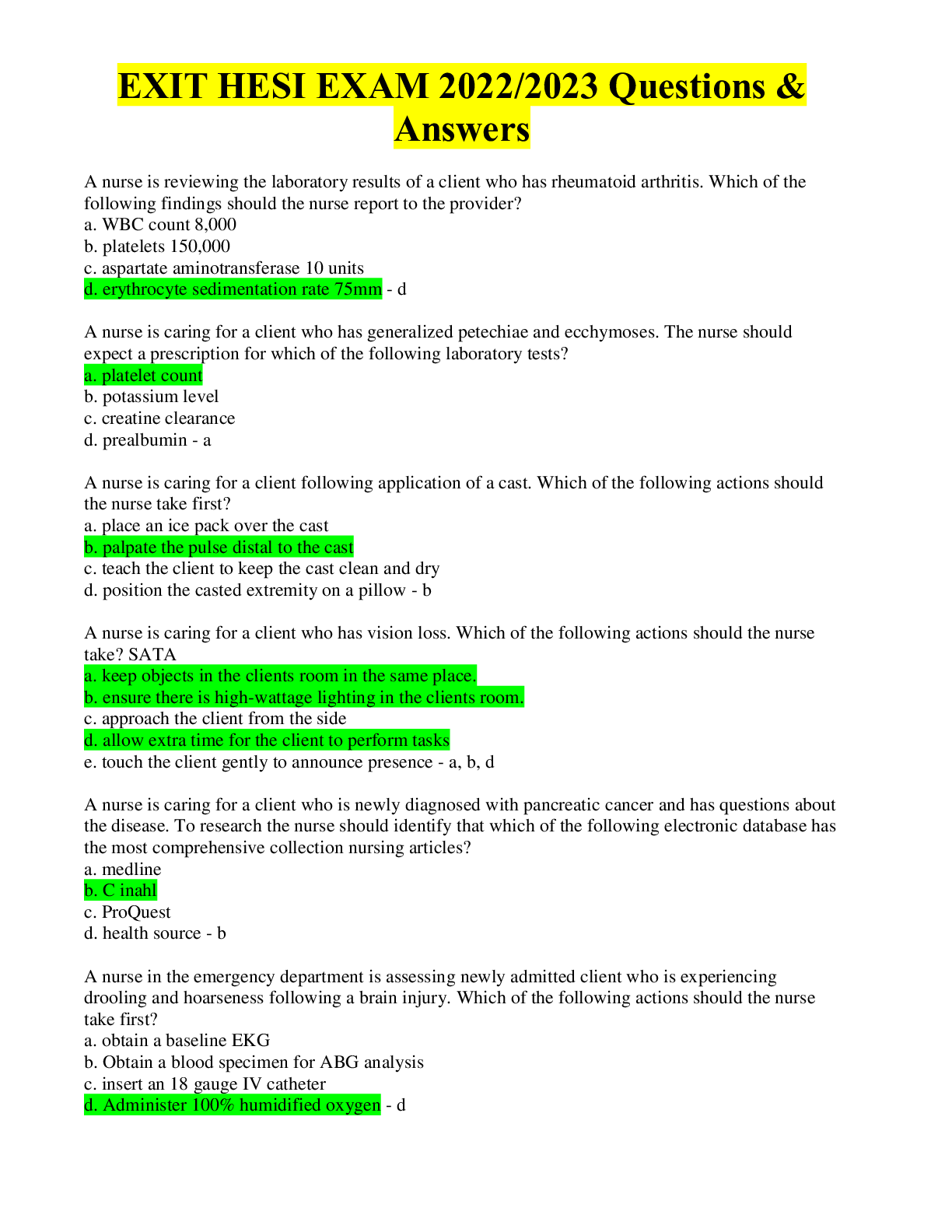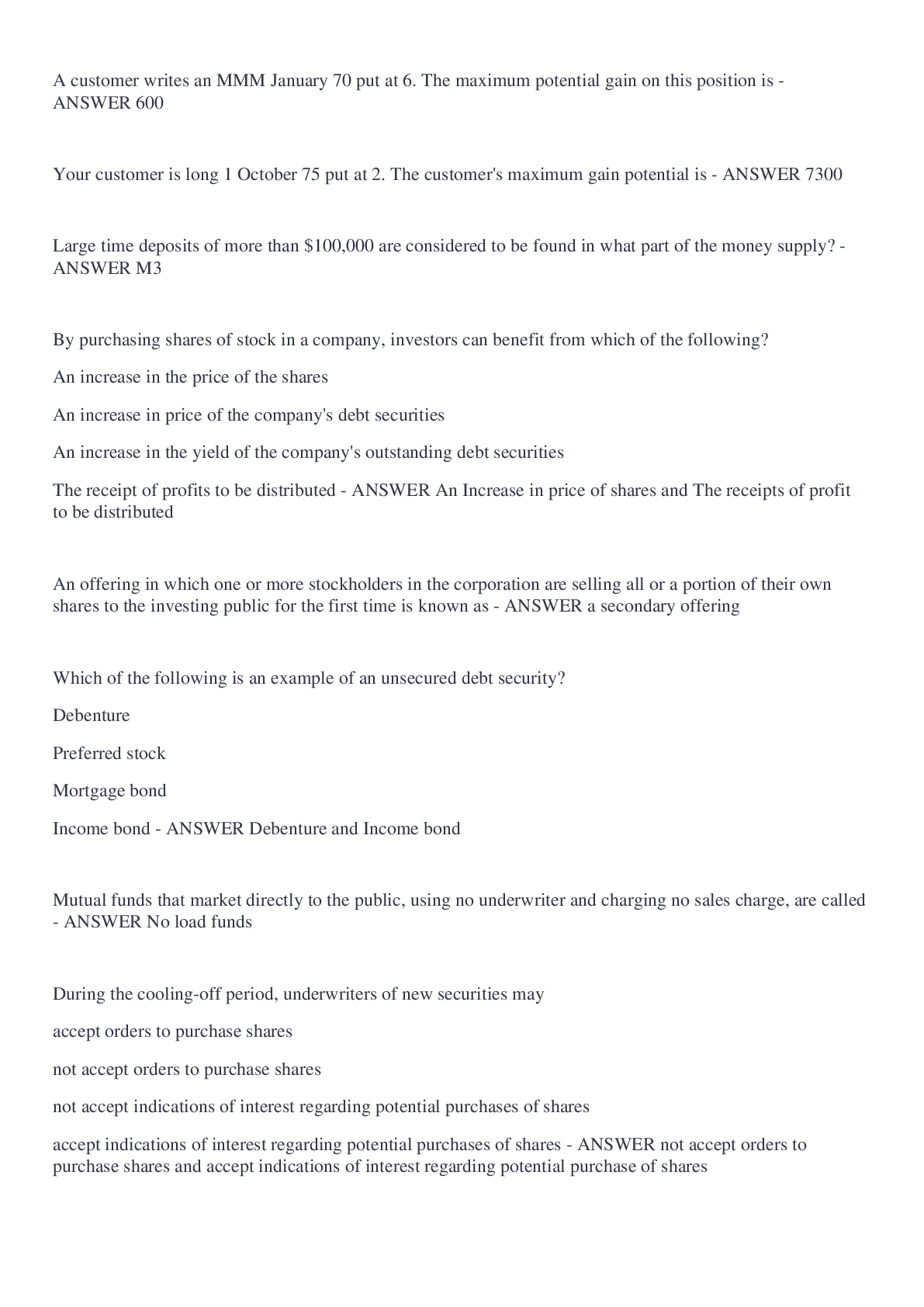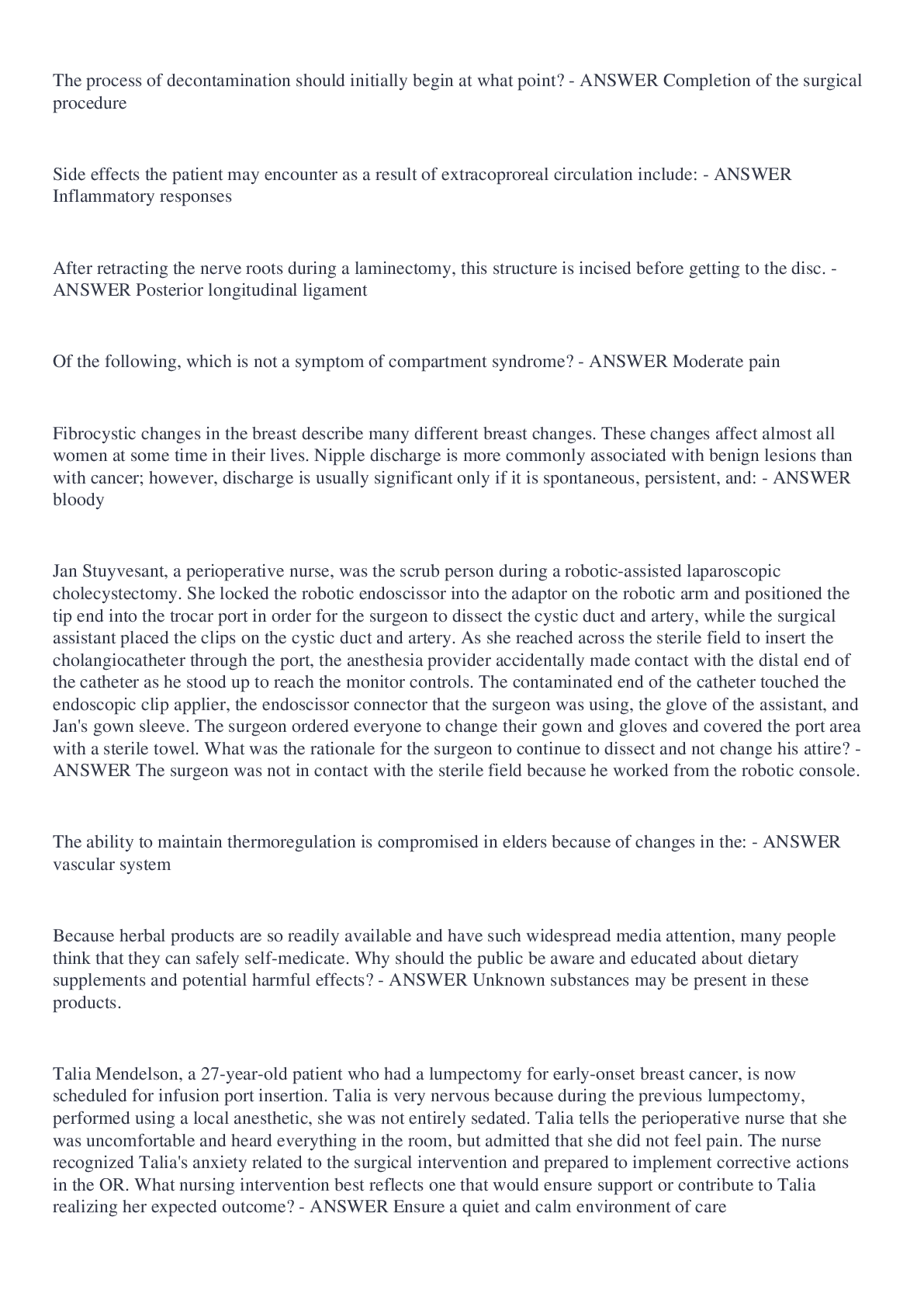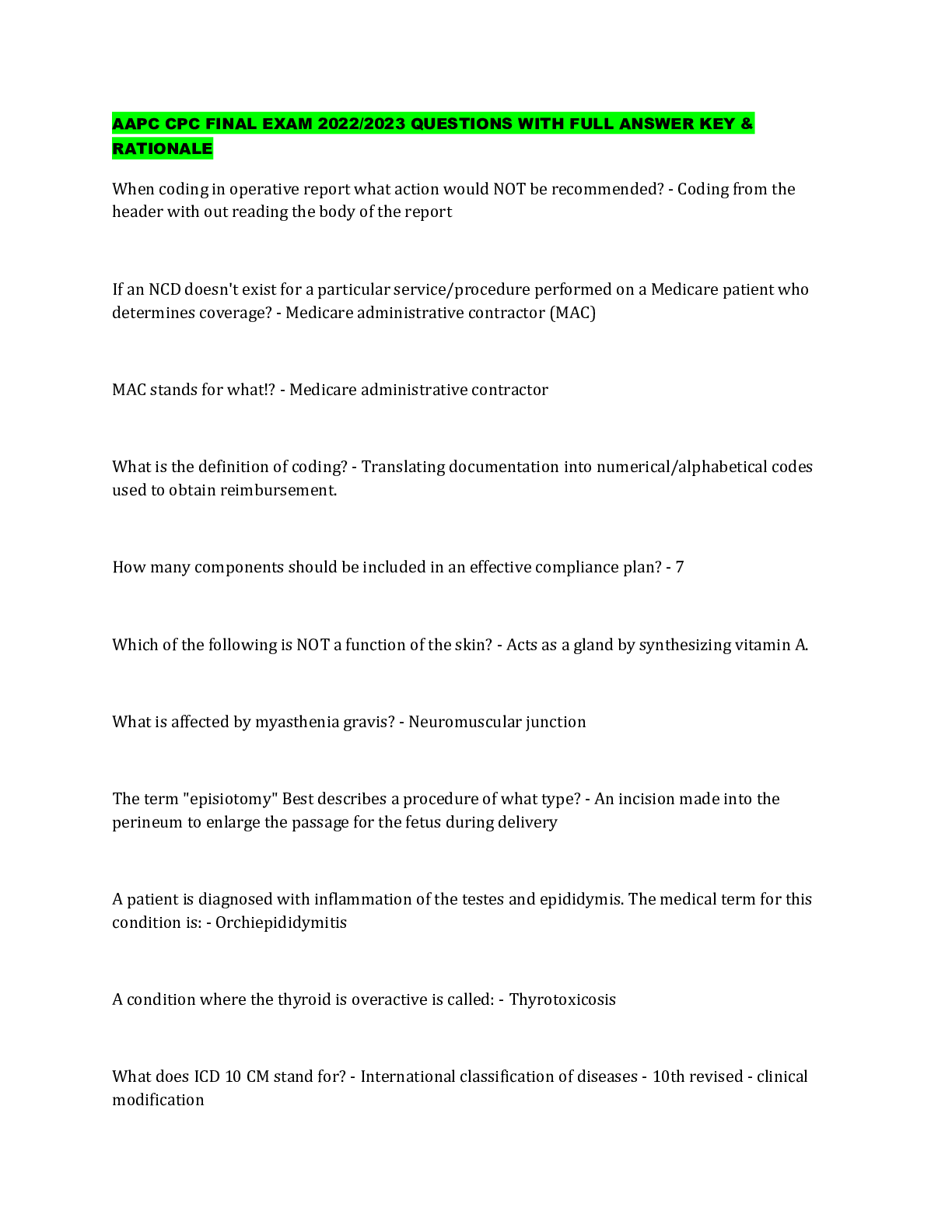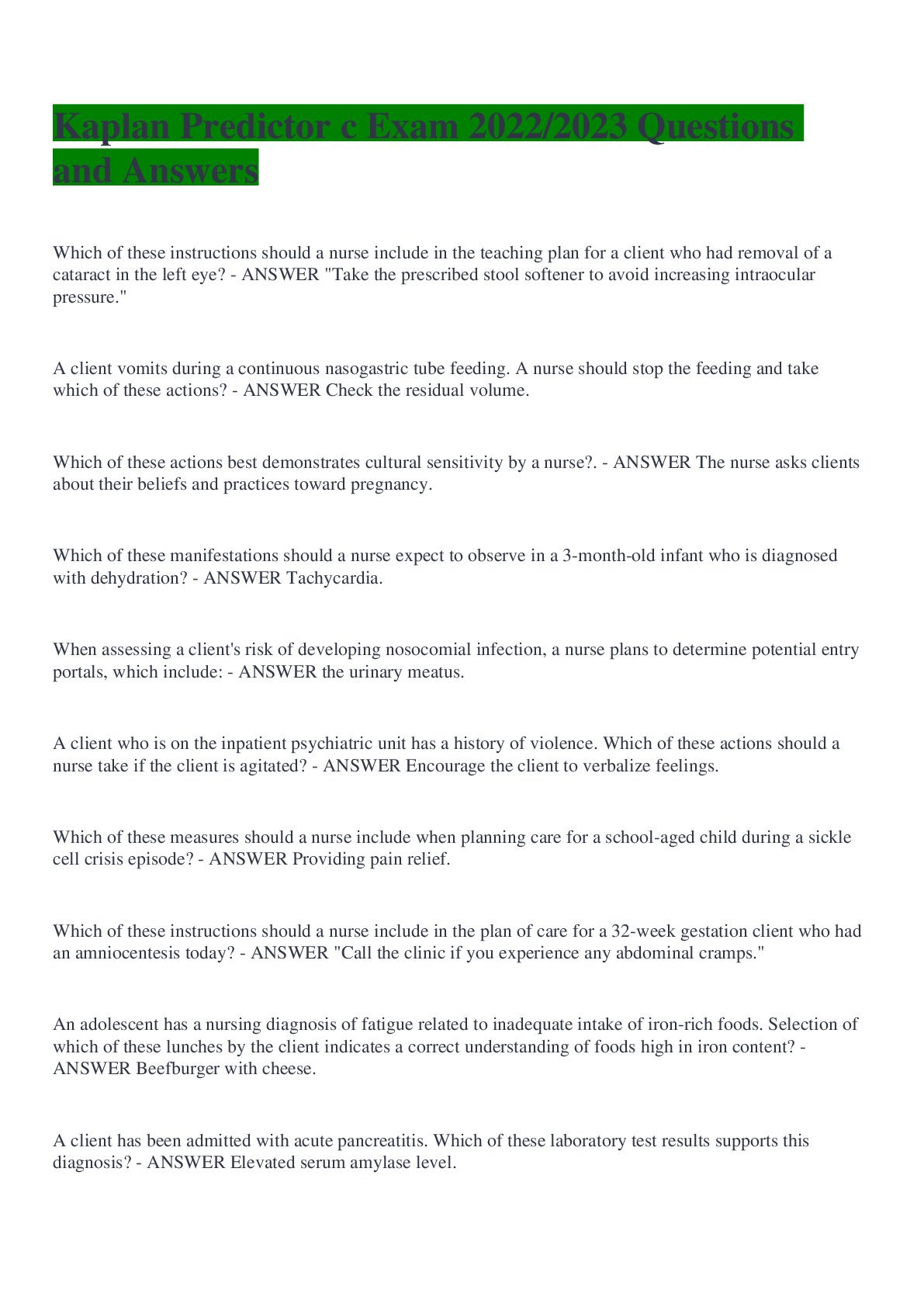NR 509 Exam 2022/2023 Questions and Answers
Document Content and Description Below
1. Which of the following changes are expected in vision as part of the normal aging process? A) Cataracts B) Glaucoma C) Macular degeneration D) Blurring of near vision - ANSWER Ans: D The lens ... loses its elasticity over time as part of the normal aging process, and the eye is less able to accommodate and focus on near objects; therefore, the patient will be expected to have blurring of near vision. 2. A 72-year-old retired truck driver comes to the clinic with his wife for evaluation of hearing loss. He has noticed some decreased ability to hear what his wife and grandchildren are saying to him. He admits to lip-reading more. He has a history of noise exposure in his young adult years: He worked as a sound engineer at a local arena and had to attend a lot of concerts. Based on this information, what is the most likely finding regarding his hearing acuity? A) Loss of acuity for middle-range sounds B) Increase of acuity for low-range sounds C) Loss of acuity for high-range sounds D) Increase of acuity for high-range sounds - ANSWER Ans: A Human speech is considered to be a middle-range sound. During the aging process there is a loss of acuity, starting with high-pitched sounds but extending to the middle range and then into the low range. 3. A 79-year-old retired banker comes to your office for evaluation of difficulty with urination; he gets up five to six times per night to urinate and has to go at least that often in the daytime. He does not feel as if his bladder empties completely; the strength of the urinary stream is diminished. He denies dysuria or hematuria. This problem has been present for several years but has worsened over the last 8 months. You palpate his prostate. What is your expected physical examination finding, based on this description? A) Normal size, smooth B) Normal size, boggy C) Enlarged size, smooth D) Enlarged size, boggy - ANSWER Ans: C This is the expected physical examination finding in benign prostatic hyperplasia (BPH). 4. A 70-year-old retired auto mechanic comes to your office because his neighbor is concerned about his memory. The patient himself admits to misplacing his keys more often and forgets what he is supposed to buy from the grocery store and where he has parked the car. He denies getting lost in familiar places. Upon further questioning, he states that his wife of 40 years died 8 months ago; his three children live in three different states; and he has limited his activities because the people he interacted with were "his wife's friends, not his." He drinks a six-pack of beer daily; he does not smoke or use illicit drugs. You perform a mini-mental state examination and obtain a total score of 24 out of 28. Based on this information, what is your most likely diagnosis? A) Benign forgetfulness B) Dementia C) Meningitis D) Depression - ANSWER Ans: D The patient has symptoms of depression: His wife died, he has no real social support system, and he has isolated himself from his usual activities. He also drinks a considerable amount of alcohol on a daily basis, which can further depress his mood. Depression can masquerade as dementia in the elderly and must be considered in a patient with memory loss. 5. An 85-year-old retired teacher comes to your office for evaluation of weakness. You obtain a complete history, perform a thorough physical examination, and order laboratory tests. You diagnose her with hyperthyroidism. Based on her age, which of the atypical symptoms of hyperthyroidism is more likely to be seen? A) Fatigue B) Weight loss C) Tachycardia D) Anorexia - ANSWER Ans: D This is an atypical symptom of hyperthyroidism that is more likely to be seen in the older patient. 6. A 78-year-old retired seamstress comes to the office for a routine check-up. You obtain an ECG (electrocardiogram) because of her history of hypertension. You diagnose a previous myocardial infarction and ask her if she had any symptoms related to this. Which of the following symptoms would be more common in this patient's age group for an acute myocardial infarction? A) Chest pain B) Syncope C) Pain radiating into the left arm D) Pain radiating into the jaw - ANSWER Ans: B This is an atypical symptom and more likely to be seen in this patient's age group. 7. An 88-year-old retired piano teacher comes for evaluation of fatigue. You notice that her clothes are hanging loosely off her frame and that she has lost 15 pounds. She is unaware of this. Her husband of 63 years died a few months ago. You ask the patient to complete a Rapid Screen for Dietary Intake. Which of the following statements is considered to be part of this rapid screen? A) I eat more than two meals per day. B) I drink one glass of alcohol every day. C) Without wanting to, I have lost or gained 10 pounds in the last 6 months. D) I eat with at least one other person most of the time. - ANSWER Ans: C This is part of the Rapid Screen for Dietary Intake. 8. An 89-year-old retired school principal comes for an annual check-up. She would like to know whether or not she should undergo a screening colonoscopy. She has never done this before. Which of the following factors should not be considered when discussing whether she should go for this screening test? A) Life expectancy B) Time interval until benefit from screening accrues C) Patient preference D) Current age of patient - ANSWER Ans: D The current age of the patient is not as important as her actual life expectancy and current health status. 9. Which of the following booster immunizations is recommended in the older adult population? A) Tetanus B) Diphtheria C) Measles D) Mumps - ANSWER Ans: A Older adults who have received the primary series of three tetanus immunizations should receive the single booster dose of tetanus immunization every 10 years. 10. You are asked to perform a home safety assessment for an 87-year-old retired farmer who lives by himself. Which of the following is not considered to be an increased risk for falls? A) Loose electrical cords B) Slippery or irregular surfaces C) Chairs at awkward angles D) Bright lighting - ANSWER Ans: D Bright lighting is a recommendation to improve an older person's ability to see all possible things that could result in a fall. 11. A 73-year-old retired accountant comes to your office for her annual examination. She has incontinence of urine when she coughs or sneezes. She takes several medications for control of hypertension and diabetes. You use the DIAPERS mnemonic to assess the cause of her incontinence. All of the following are items represented by the mnemonic except for: A) Atrophic vaginitis B) Depression C) Pharmaceuticals D) Restricted mobility - ANSWER Ans: B Depression is not a risk factor for incontinence. The D in the mnemonic stands for delirium. 12. Which of the following brief screening measures is useful in assessing memory? A) Three-item recall B) Serial 7s C) Spelling "world" backward D) Copying intersecting pentagrams - ANSWER Ans: A If the patient is unable to remember three items after 1 minute has passed, then this is a positive screening test and indicates a need for further testing. This is part of the "10-Minute Geriatric Screener." 13. Which of the following questions is part of the screening for physical disability? A) Are you able to go shopping for groceries or clothes? B) Are you able to walk one block? C) Are you able to pass the driver's license test? D) Are you able to perform light dusting and pick up after yourself around the house? - ANSWER Ans: A This is part of the Physical Disability screening portion of the 10-Minute Geriatric Screener. 14. It is summer and an 82-year-old woman is brought to you from her home after seeing her primary care doctor 2 days ago. She was started on an antibiotic at that time. Today, she comes to the emergency room not knowing where she is or what year it is. What could be a likely cause of this? A) Alzheimer's dementia B) Stroke C) Delirium D) Meningitis - ANSWER Ans: C These are not signs of normal aging and seem to be of acute onset. This makes Alzheimer's less likely. Stroke and meningitis could cause these symptoms as well, but the combination of the heat and a recent infection make delirium much more likely. Though she was prescribed an antibiotic, she may not have improved because of bacterial resistance or because of noncompliance due to cost, depression, or even an underlying mild dementia. Dementia should not result in an acute mental status change, although illness may cause a worsening of dementia. 15. Blood pressure abnormalities found more commonly in Western elderly include which of the following? A) Isolated elevation of the diastolic BP B) Narrow pulse pressure C) Elevation of the systolic BP D) Elevation of the BP with standing - ANSWER Ans: C Isolated systolic hypertension is common in the elderly because of stiffening of the large arteries. This is often accompanied by widening of the pulse pressure. Orthostatic BP changes are often seen with postural changes and can account for falls as well. 16. Which of the following represents age-related changes in the lungs? A) Decrease in chest wall compliance B) Speed of expiration increases C) Increase in respiratory muscle strength D) Increased elastic recoil of lung tissue - ANSWER Ans: A The lungs age along with the rest of the body. These changes include decreased lung and chest wall compliance, increased expiratory time, decreased muscle strength and cough, and decreased elastic recoil. 17. Mrs. Stanton is a 79-year-old widow who presents to your office for a routine BP visit. You note a new pulsatile mass in the right neck at the carotid artery. Which of the following is the most likely cause for this? A) Anxiety B) Carotid artery aneurysm C) Kinking of the artery D) Tortuous aorta - ANSWER Ans: C While a carotid artery aneurysm is a possibility, it is more likely due to kinking of the carotid artery in this patient with HTN. A tortuous aorta will sometimes cause elevation of the left jugular vein by impairing drainage within the thorax. 18. Mr. Chin is an 82-year-old man who comes to your office for a routine check. On examination, you notice a somewhat high-pitched murmur in the second right intercostal space during systole. It does not radiate and the rest of his examination is normal for his age. Which is true of the most likely cause of this murmur? A) It often decreases carotid upstroke. B) It carries with it increased risk for cardiovascular disease. C) It is usually accompanied by an S3 gallop. D) It is found in 10% of otherwise normal elderly patients. - ANSWER Ans: B This murmur most likely represents aortic sclerosis, a common murmur affecting about one third of those near 60 years of age. It is caused by calcification of the valve and is associated with cardiovascular risk. Aortic sclerosis does not usually cause obstruction to normal flow, so carotid upstroke should be normal, and it is not associated with an S3 gallop. 19. Mrs. Buckley is a 75-year-old widow who wants you to look at her teeth because over the past 2 weeks she has had right-sided jaw pain when eating. It does not occur otherwise. She also has had a headache. Which of the following should be considered? A) Palpation of her temples B) Dental referral C) Ultrasound of the gallbladder D) Inquiry about anosmia - ANSWER Ans: A This story can be consistent with temporal arteritis, which can cause blindness in 15% of those affected. Early recognition is crucial. Most of these patients will have tenderness over one or both of the temporal arteries, and some have diminished temporal pulses as well. Early treatment with corticosteroids is indicated. It can also be associated with polymyalgia rheumatic, a condition which causes pain in the shoulder girdles and pelvis. 20. Which of the following is commonly seen in aging men? A) Erectile dysfunction in 20% of all men B) Testicles ride higher within the scrotum C) Strong response to visual erotic cues D) Persistent sexual interest - ANSWER Ans: D Erectile dysfunction affects about half of elderly men but sexual interest generally remains intact. A decrease in sexual interest may indicate other problems such as depression. Visual cues become less important and tactile stimulation more important. The testicles are positioned lower in the scrotum. 21. Which of the following accompanies decreased ovarian function? A) Increased sleep B) Diminution of sexual interest C) Enlargement of the clitoris D) Decrease in vaginal secretions - ANSWER Ans: D Menopause, or the cessation of menses for 1 year, commonly occurs in the late 40s to early 50s. Many experience hot flashes, sweating, chills, anxiety, decreased sleep, a [Show More]
Last updated: 1 year ago
Preview 1 out of 9 pages
Instant download
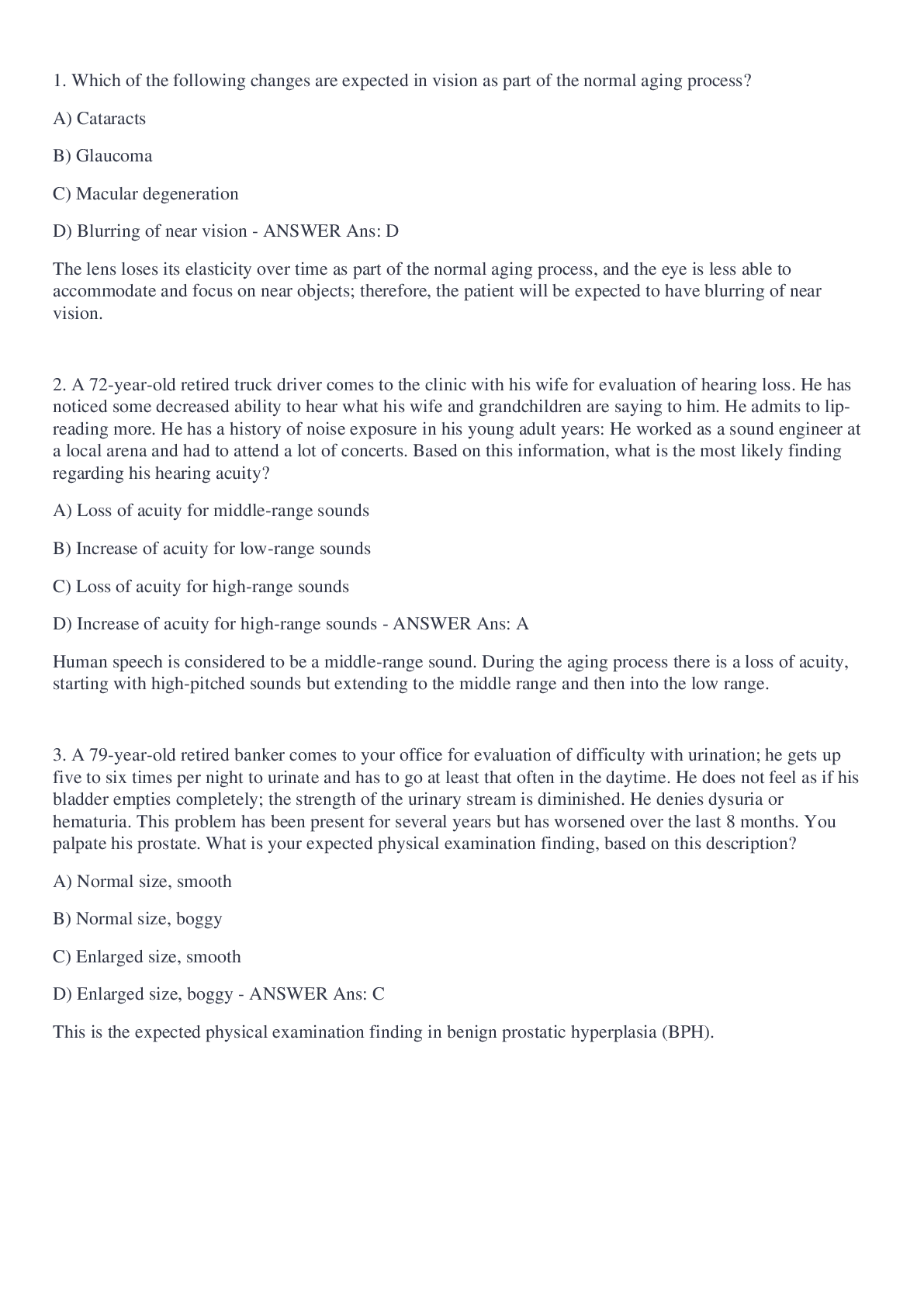
Instant download
Reviews( 0 )
Document information
Connected school, study & course
About the document
Uploaded On
Jul 26, 2022
Number of pages
9
Written in
Additional information
This document has been written for:
Uploaded
Jul 26, 2022
Downloads
0
Views
33





